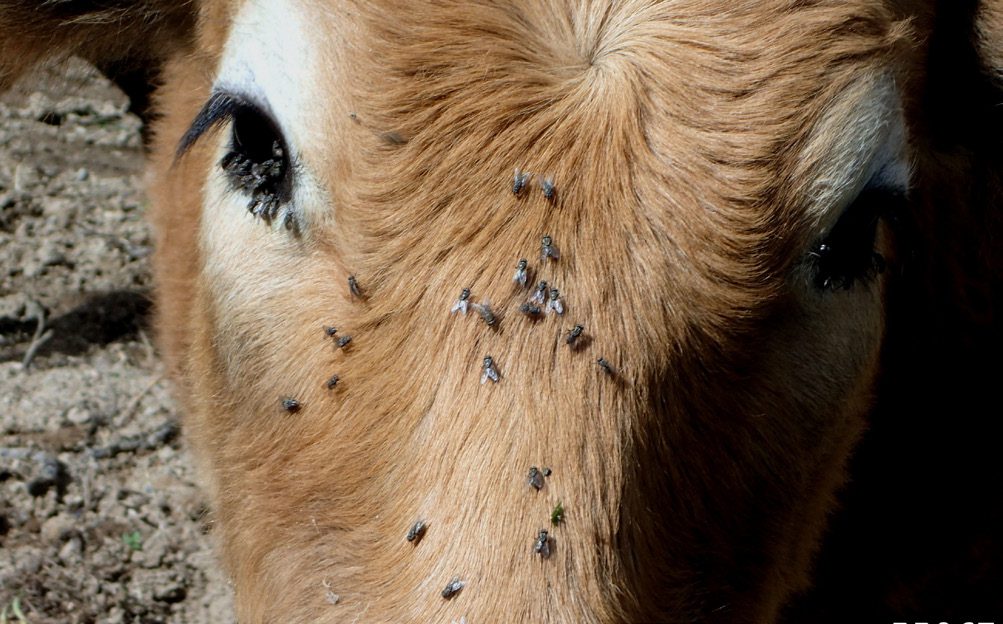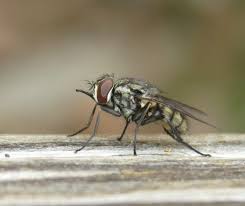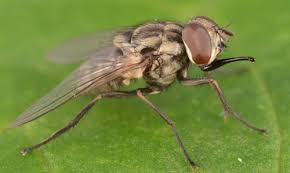Flies, such as stable flies (Stomoxys calcitrans) and horn flies (Haematobia irritans), are common insects that play a significant role in various ecosystems. These small creatures, though often overlooked, have intriguing characteristics and can impact both humans and animals.
Stable flies, scientifically known as Stomoxys calcitrans, are nuisance pests that commonly infest areas where livestock is present. These flies are distinguishable by their dark color and the checkerboard pattern on their abdomen. Known for their painful bites, stable flies feed on the blood of animals, causing discomfort and irritation. Their presence can also lead to reduced productivity in livestock, as animals may exhibit stress and agitation.
Horn flies, scientifically designated as Haematobia irritans, are another species of fly that primarily affects cattle. These small, dark-colored flies gather in large numbers on the backs and sides of cattle, where they feed on blood. The constant irritation caused by horn flies can result in decreased weight gain and milk production in cattle, impacting the agricultural industry.
Flies, in general, serve as vectors for various diseases. They can transmit pathogens from one host to another as they move from place to place. This makes them potential carriers of diseases that affect both humans and animals. Proper pest management and hygiene practices are crucial in controlling the spread of diseases associated with flies.
Understanding the life cycle of flies is essential in devising effective control strategies. Flies undergo a complete metamorphosis, transitioning from eggs to larvae, pupae, and finally, adult insects. Interrupting this life cycle through measures such as sanitation and insecticide application can help mitigate fly infestations.
However, flies, including stable flies and horn flies, may be small, but their impact on both agriculture and public health should not be underestimated. Implementing proper control measures and maintaining good hygiene practices are vital to minimize the negative effects of these insects on livestock, humans, and the environment.
Read Also: Long Haired Cat Breeds Description and Complete Care Guide
Animals Affected by Flies (Stomoxys calcitrans)

Flies can affect a wide range of animals, causing various issues and health concerns. Livestock, domestic pets, and even wildlife can fall victim to the nuisance and potential harm brought about by flies.
1. Livestock: Cattle, sheep, goats, horses, and other farm animals are particularly susceptible to fly infestations. Stable flies and horn flies, in particular, can cause stress and discomfort to livestock. Bites from these flies may lead to reduced weight gain, lower milk production, and overall economic losses in the agricultural sector.
2. Pets: Domestic pets, such as dogs and cats, can also be affected by flies. Flies can irritate pets by buzzing around them or biting, causing discomfort and stress. Additionally, flies may carry diseases and parasites that can be transmitted to pets, leading to potential health issues.
3. Wildlife: Various wildlife species, ranging from birds to mammals, can experience the adverse effects of fly infestations. Flies may contribute to the spread of diseases among wildlife populations, impacting their overall health and survival. Insects like botflies, which lay their eggs on the skin of mammals, can affect wild animals and cause skin lesions or other health problems.
4. Farm Animals: Beyond traditional livestock, animals like poultry and rabbits can also be affected by flies. Flies may contribute to unsanitary conditions in and around animal enclosures, potentially leading to the spread of diseases and affecting the well-being of these animals.
flies have the potential to impact a broad spectrum of animals, influencing their health, productivity, and overall quality of life. Effective pest management strategies are essential to mitigate the negative consequences of fly infestations on diverse animal populations.
Damages Caused by Flies

Flies can inflict various damages, affecting both humans and animals, while also posing economic and health concerns. The impact of flies encompasses a range of issues, from direct harm to the transmission of diseases.
1. Economic Losses in Agriculture: Flies, especially stable flies and horn flies, can cause significant economic losses in the agricultural sector. Livestock, such as cattle, often experience reduced weight gain and lower milk production due to constant irritation from fly bites. This can lead to decreased overall productivity and financial losses for farmers.
2. Spread of Diseases: Flies are notorious for transmitting diseases. They act as vectors, carrying pathogens on their bodies and transferring them from one host to another. This poses a considerable threat to both humans and animals. Diseases such as bacterial infections, viral diseases, and parasitic infestations can be transmitted through fly bites, contributing to health problems in affected populations.
3. Impact on Wildlife: Wildlife populations can also suffer from the damages caused by flies. The spread of diseases among wild animals can disrupt ecosystems and lead to declines in certain species. Additionally, parasitic flies may adversely affect the health and survival of wildlife, influencing the balance of ecosystems.
4. Discomfort and Stress: The constant presence of flies can cause discomfort and stress in animals. Infestations may lead to animals exhibiting nervous behaviors, reduced feeding, and disrupted sleep patterns. This not only affects the well-being of individual animals but can also have cascading effects on the overall health of populations.
5. Public Health Concerns: Flies in urban and rural areas can pose public health concerns. They are capable of carrying disease-causing microorganisms, contaminating food and water sources. In environments where sanitation is compromised, flies contribute to the spread of diseases among human populations.
The damages caused by flies extend beyond mere annoyance. From economic losses in agriculture to the transmission of diseases affecting both animals and humans, the impact of flies underscores the importance of effective pest management strategies to mitigate these various threats.
Read Also: Ocicat Cat (Felis catus) Description and Complete Care Guide
Control and Preventive Measures

Implementing effective control and preventive measures is crucial in managing fly populations and minimizing the damages they can cause. Here are some key strategies:
1. Sanitation Practices: Regular cleaning of animal enclosures, barns, and surrounding areas helps eliminate breeding sites for flies.
Proper disposal of manure and waste reduces the attractiveness of environments conducive to fly reproduction.
2. Biological Control: Introducing natural predators, such as parasitic wasps and predators like spiders, can help control fly populations. Nematodes, microscopic organisms that feed on fly larvae, can be applied to areas with high fly activity.
3. Insecticides: Using approved insecticides can be an effective method for controlling adult fly populations. Targeted application of insecticides to breeding areas, resting sites, or directly on animals can help reduce fly numbers.
4. Fly Traps: Installing fly traps in strategic locations can capture adult flies and disrupt their life cycle. Various types of traps, including sticky traps and baited traps, can be used to target specific fly species.
5. Animal Management: Providing animals with shelters and shade can reduce their exposure to flies. Practices like rotating grazing areas for livestock can help break the cycle of fly infestations.
6. Veterinary Care: Regular veterinary check-ups and appropriate healthcare measures for animals can prevent and treat conditions resulting from fly bites. The use of veterinary-approved insect repellents on animals can offer additional protection.
7. Environmental Modifications: Modifying the environment by using screens on windows and doors can prevent flies from entering living spaces. Proper waste management in urban areas is essential to reduce fly populations in human-inhabited spaces.
8. Public Education: Raising awareness among the public, farmers, and animal owners about the importance of fly control measures. Encouraging community participation in maintaining clean and hygienic surroundings to minimize fly breeding sites.
However, a multifaceted approach involving sanitation, biological control, insecticides, and animal management is necessary for effective fly control and prevention. Implementing these measures collectively can help mitigate the negative impacts of fly infestations on agriculture, animal health, and public well-being.
Frequently Asked Questions (FAQs) About Flies (Stomoxys calcitrans)
1. Q: What are stable flies and horn flies?
A: Stable flies (Stomoxys calcitrans) and horn flies (Haematobia irritans) are common fly species that often infest livestock. Stable flies are known for their painful bites, while horn flies predominantly affect cattle.
2. Q: How do flies impact livestock?
A: Flies, especially stable and horn flies, can cause stress and discomfort to livestock. Bites can lead to reduced weight gain, lower milk production, and economic losses in agriculture.
3. Q: What diseases can flies transmit?
A: Flies act as vectors for various diseases, transmitting pathogens from one host to another. Diseases include bacterial infections, viral diseases, and parasitic infestations that can affect both animals and humans.
4. Q: How can I control fly infestations in livestock areas?
A: Implementing good sanitation practices, using biological control methods, applying approved insecticides, and providing proper animal management are effective strategies to control fly populations.
5. Q: Are there natural predators for flies?
A: Yes, natural predators like parasitic wasps and spiders can help control fly populations. Nematodes, microscopic organisms, are also effective in controlling fly larvae.
6. Q: Can flies affect pets and wildlife?
A: Yes, flies can impact domestic pets, causing irritation and potential health issues. Wildlife populations can also be affected by the spread of diseases carried by flies.
7. Q: How do I protect my animals from fly bites?
A: Providing shelters, using veterinary-approved insect repellents, and practicing good animal management, such as rotating grazing areas, can help protect animals from fly bites.
8. Q: What are some preventive measures for fly control?
A: Regular cleaning, proper waste disposal, environmental modifications (such as screens on windows), and public education on hygiene are essential preventive measures for controlling fly populations.
9. Q: Can fly infestations pose public health concerns?
A: Yes, flies can carry disease-causing microorganisms, posing public health concerns. Proper sanitation and waste management are crucial in minimizing these risks.
10. Q: How do I recognize stable flies and horn flies?
A: Stable flies are distinguishable by their dark color and a checkerboard pattern on their abdomen. Horn flies are small, dark-colored flies that gather on the backs and sides of cattle.
Read Also: How to Make Your Own Organic Pesticides
